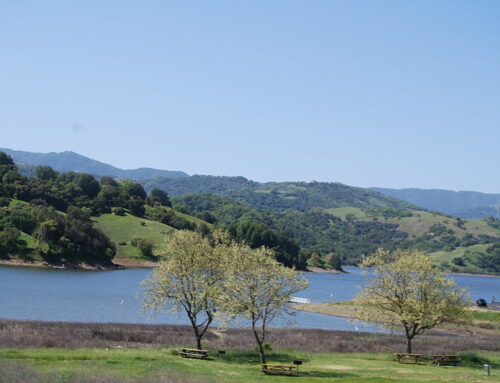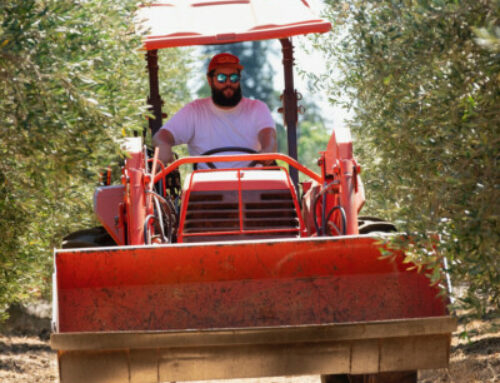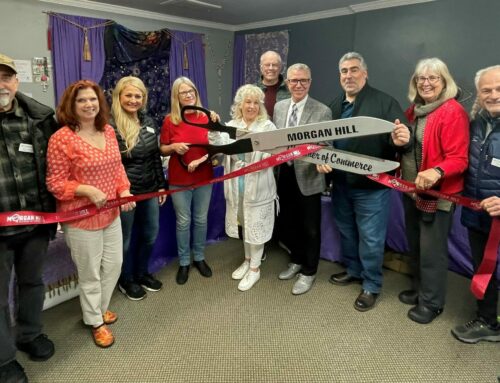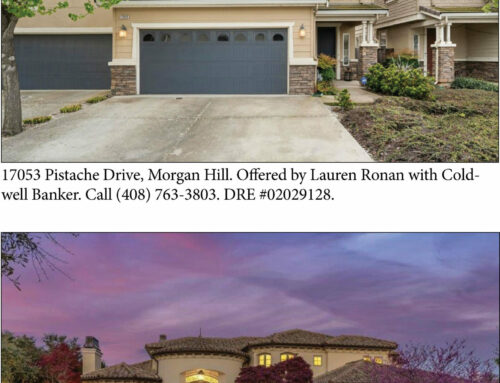Still many questions to answer before 800-mile route can be constructed
Published in the Sept. 30 – Oct. 13, 2015 issue of Morgan Hill Life
By Marty Cheek

Photo by Marty Cheek
Ben Tripousis, northern regional director for the California High-Speed Rail Authority, shows a map with proposed routes through Morgan Hill.
If completed, the California High-Speed Rail line will be the most expensive public works project in American history. The 800-mile high-tech transportation system has both opponents and supporters who say it will have a direct impact on the quality of life of Morgan Hill and the rest of the South Valley.
Concerns and criticism as well as support for the project were brought up by citizens at a community meeting held at the Morgan Hill Community and Cultural Center Sept. 23. Among the critics was Yvonne Sheets-Saucedo, an advocate for the Palo Alto-based Californians Advocating Responsible Rail Design. Although the group is not opposed to high-speed rail itself, it does not favor the current design of the system presented by the California High-Speed Rail Authority which is constructing the project, she said.
“Just the footprint and the sheer magnitude of this project for this valley, this will be a singular transformational event,” she said. “It changes everything. I’ve not heard, and I’m certainly not convinced on any level that it translates into a betterment for this community. It provides many more burdens than benefits.”
Trina Hineser, a San Martin resident of about 20 years and a member of the board of directors of the San Martin Neighborhood Alliance, also expressed concerns about the high-speed trains that might one day cut through the rural community south of Morgan Hill. She’s concerned about issues such as graffiti, trash and homeless encampments along the tracks, as well as urban sprawl and increased traffic with potential home developments along the line. She does not want to see San Martin property owners forced to sell their land in eminent domain cases such as what is happening in the stretch of high-speed rail construction now being built between Merced and Bakersfield in the Central Valley.
The SMNA opposes the project, Hineser said.
“It’s going to change the community,” she said. “Our position is that we feel our state should take care of our roads and our traffic issues in a different way. This is not something that we want to see going through here. I can understand if they want to just go down Interstate 5, but when you’re bringing it through our particular area, we’re not in favor of it.”
Other residents of the South Valley region expressed opinions in favor of the project. Downtown Morgan Hill resident Kim Bush, who did not attend the Sept. 23 meeting, said she thinks high-speed rail for California is a “very good idea” and she would like to one day use the system to travel on day-trips to cities such as Salinas and Sacramento, as well as Los Angeles to attend film festivals there.
“I think we need to reduce our carbon footprint and get off the roads as much as we can,” she said. “We already have trains going through the downtown. We have three commuter trains in the morning and evening. Amtrak just rushes through. We have freight trains. So I don’t see any difference in having high-speed go through here.”
In November 2008, voters approved Proposition 1A, which authorized the state to issue $9 billion dollars in bonds to build a new high-speed rail system. By the end of Phase 1, which is projected to be completed in 2029, the route will connect Los Angeles with San Francisco with trains carrying passengers at speeds of up to 220 miles per hour in open spaces and 110 miles per hour through communities, according to the rail authority. A “one-seat ride” could take travelers from San Francisco to Union Station in downtown Los Angeles in two hours and 40 minutes, according to the authority. The estimated total cost of the project has wavered during the years, and is currently projected to be $67 billion, according to the authority’s Northern Regional Director Ben Tripousis.

Photo courtesy High-Speed Rail Authority
An artist’s rendering of what a High-Speed Rail train might look like.
Because Caltrain has completed its environmental review to design and build a commuter rail electrification project, the high-speed rail project can start to complete its own environmental review for high-speed service from San Francisco and the Central Valley, he said. This review is expected to be completed at the end of 2017 and requires public comment, one of the reasons the authority is now starting to hold a series of community meetings in the Bay Area including last week’s in Morgan Hill. Construction will take place following the review, but no schedule is set, Tripousis said.
“Tonight’s open house is the beginning of the conversation with the local community,” he said. “We’ll be scheduling technical working groups with city staff and other agency staff to talk about the alternatives (of routes through the South Valley) that have already been looked at. We’ll be talking with community members about those alternatives and as we get everyone’s input, that will make a determination about which of those and how those alignments ought to go forward.”
One question for the South Valley is whether or not the high-speed rail will go near Monterey Road, passing through downtown Morgan Hill, or go along either the east or west side of U.S. 101. The location of a Gilroy station on the route (either built downtown or near the Premium Outlets along the freeway) will play a major role in determining one of those routes.
The track between San Francisco to San Jose will be a “blended section” where high-speed trains will operate on Caltrain’s electrified tracks. South of San Jose, high-speed rail will have its own dedicated tracks separate from Caltrain, Amtrak and freight lines. From the Gilroy station, the line will turn east and pass through Pacheco Pass to Merced and then Fresno.
Complicating the construction is the fact that the tracks will pass through 20 communities in the San Francisco Bay Area and each of these communities has a different perspective on how they want high-speed rail to be incorporated through their city.
One of the biggest concerns by South Valley residents about building the high-speed tracks is the impact it will have on traffic flow through city streets, especially if the decision is made to build it through downtown Morgan Hill if it follows Monterey Road. The design of the track system will be “fully grade separated” to alleviate this issue, said Lisa Marie Alley, deputy director of public affairs with the rail authority.
“Right now you can cross a grade on your car or you can walk across the train tracks,” she said. “Over time, no one will be allowed to do that, so that traffic will go either up above or below our train tracks so that traffic will not need to stop. We’ll determine where those grade separations will go when we do our traffic analysis, so there won’t be that backup.”
Another concern raised by citizens is the decibel level of sound produced by trains speeding through communities.
“From a noise perspective, high-speed trains, believe it or not, actually have a lower noise than freight and the current diesel trains used by Caltrain, Amtrak and others,” Alley said. “So the noise is much quieter because we’re an all-electric system. And when we don’t have grate-crossings, (the train driver) won’t have to toot the horns because you don’t have those (crossings) arms going up and down.”
The rail authority will do an in-depth noise evaluation to alleviate any problems, Tripousis said.
“On average, if you take high-speed rail internationally, electric trains are anywhere from three to 10 decimals quieter than diesel is right now,” he said. “And of course it depends on the speed you’re going and the location, and surrounding ambient noise.”
Right-of-way and eminent domain concerns also were raised by community members. Alley said that the rail authority will follow federal and state laws to acquire South Valley properties and will strive to acquire the property through negotiations.
“If, unfortunately, we have to go down the route of possibly going through eminent domain, there are the state and federal laws set forth that we need to follow,” she said.
Safety of the system is another concern brought up. The rail authority is looking into using advanced technology such as early earthquake warning systems and positive train control such as those used in high-speed rail systems in Japan, Alley said.
“Japan has had high-speed rail for 50 years. They’ve not had one single accident,” she said. “And they have a similar set-up to California.
The system will be “energy net-zero,” as required by Proposition 1A, and the electric trains will be powered by non-carbon sources including solar, wind and biomass.
The complex system of high-speed tracks across the Bay Area and the rest of California will take many years to accomplish, and the rail authority encourages South Valley citizens to be involved now in the discussion of its design and location at future meetings, Tripousis said.
“At the end of the day, our goal is to work with the community and develop something that is an asset and not an eye-sore,” he said. “We want it to be something the community can be proud of and serve the needs of California and still be constructed in a way that works for local communities.”






